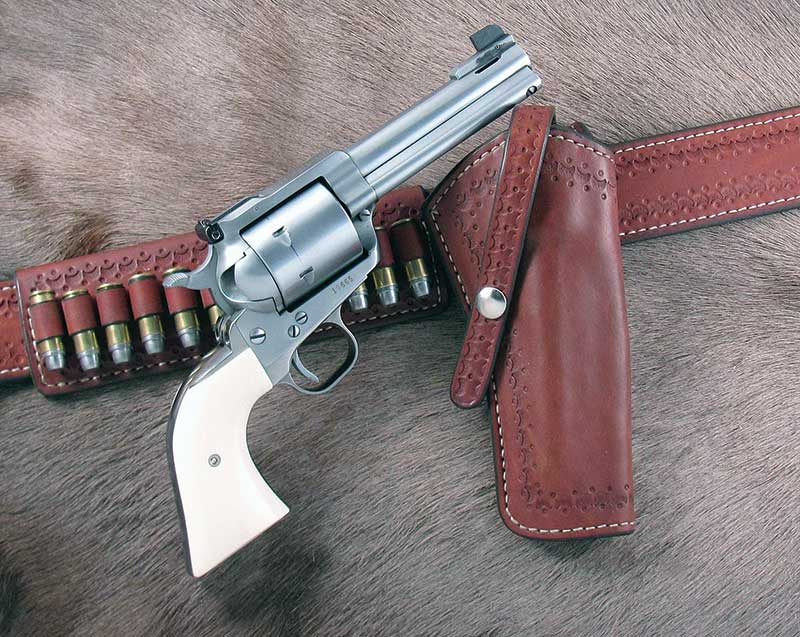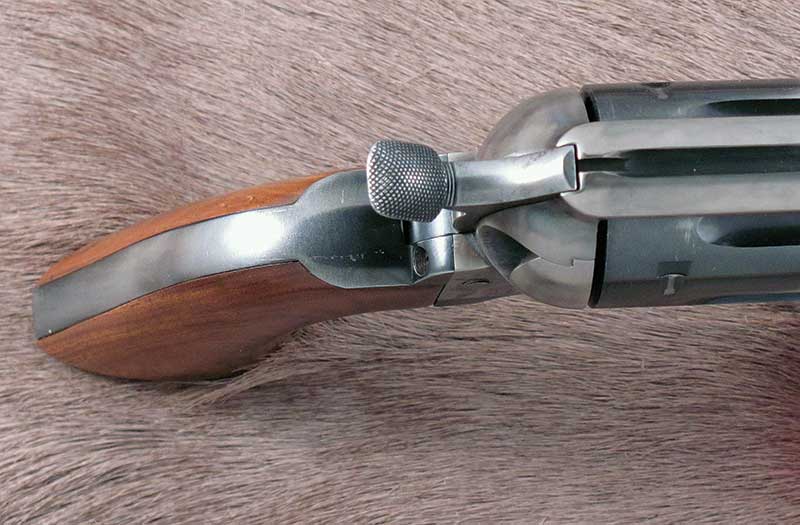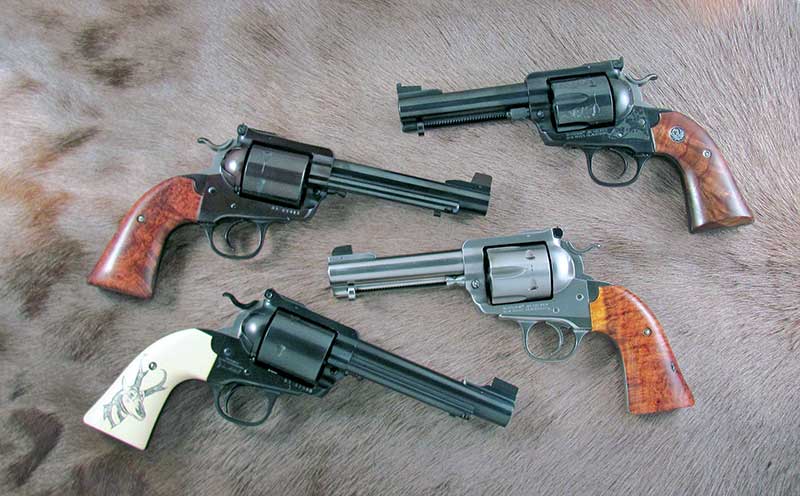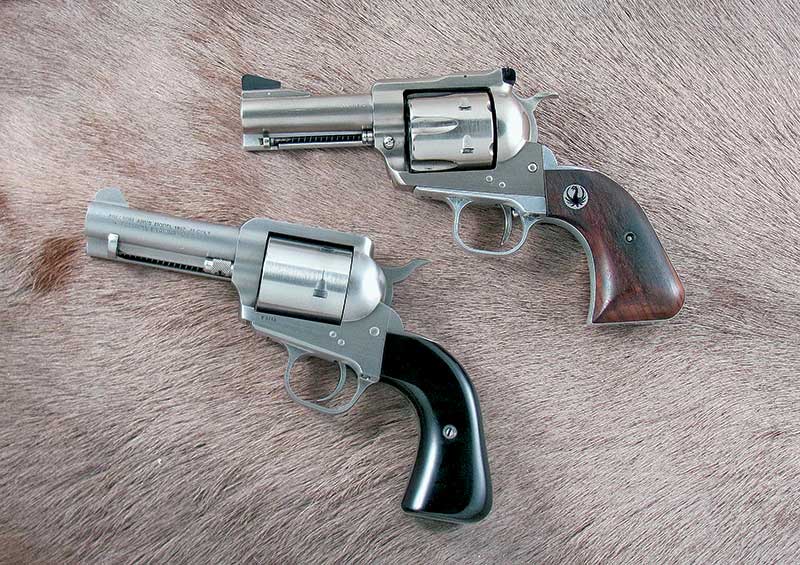Sixgun Hammers And Handles
Change 'Em To Fit
Stopping in at Buckhorn Gun I spotted an old 71/2″ Single Action Army on display. It was a 1st Generation Colt, which had been fitted with a 2nd Generation .38 Special cylinder and barrel; it also had very attractive stag stocks. However, what really caught my eye was the hammer. This was not the traditional upswept hammer found on hundreds of thousands of Single Actions but rather was of the low, wide target-style. From the period of time after World War I until the early 1950s King Gun Sight Co. was the premier supplier of custom parts for handguns. King accomplished all kinds of wonderful transformations, especially on Colt and Smith & Wesson revolvers including custom sights, ribbed barrels, short actions, and special hammers.
Here before me was a King hammer, and while I wasn’t in the market for a .38 Special Single Action I was sorely tempted to buy that sixgun just to get the hammer. The fellow who purchased the .38 Special Colt did not like the “funny looking” hammer so it was replaced with a period correct hammer and the boys at Buckhorn were told to give the King hammer to me. One of my most cherished Colts is an early 2nd Generation .44 Special with faded case colors, bluing worn on the ejector rod housing, barrel cut to 43/4″, and one-piece Pau Ferro stocks. The King hammer dropped in perfectly and the action functioned flawlessly.
Since the introduction of the Ruger Super Blackhawk all those decades ago, I have been regularly looking for better hammers and better handles, or if you please, grip frames for single-action sixguns. To shoot a single action sixgun successfully, or at least easily, requires an easy-to-reach hammer with enough surface area on the spur for easy cocking, matched up with a grip frame which helps to diminish felt recoil.
This search of mine probably started when seeing pictures of Elmer Keith’s Colt Single Actions which he had built up prior to WWII and which I was eventually able to handle. These favored Single Actions of his consisted of a 71/2″ .44 Special Custom Colt with adjustable sights by King Gun Sight, a 43/4″ Single Action .45 also with adjustable sights, and his favorite, the Number Five, or as he called it the No. 5 S.A.A. All three of these sixguns had low, wide, target-style hammers and started my personal quest for personalizing sixguns by changing hammers and handles.
Hammers
Colt hammers are not so easy to come by these days except through the hands of a custom gunsmith. But, once Ruger had established the Super Blackhawk and made parts available, I purchased several of the wide target-style hammers for use on other Rugers — a circa 1955 45/8″ .357 Blackhawk and circa 1956 61/2″ .44 Magnum Blackhawk. Both were definitely improved with the addition of Super Blackhawk hammers, and I took it a step further and had a 71/2″ Super Blackhawk barrel installed on my old original .44 Flat-Top.
Both of these sixguns are still providing great service after more than a half-century. Two more of those Super Blackhawk hammers went on custom .44 Specials. Super Blackhawk hammers are normally a drop-in affair, however you must know if you have an Old Model Three-Screw Blackhawk or one of the post-1972 New Models. For the former about the only sources now are gun shows and the Internet, while the latter is still in production.
Most of the sixgunsmiths working on Ruger Blackhawks can provide custom hammers, and two of the best I know of are David Clements and Andy Horvath both of whom can supply wide target hammers on their custom sixguns. From time to time David also offers a custom drop-in Old Model Bisley hammer. At $125 they’re not cheap and you have to get on the waiting list. However, for me, they dropped in perfectly on a pair of Old Model 45/8″ Blackhawks, one in .45 Colt and the other a .41 Magnum. These are full-blue hammers and not only improve the handling qualities but also the appearance of these old Blackhawks.
New Vaquero
About five years into the new century Ruger dropped their Vaquero — which was built on the Super Blackhawk frame — and replaced it with the New Vaquero using the .357 Blackhawk 50th anniversary cylinder and frame. The originals handle heavier loads, however the downsized New Vaquero makes a more practical every day working sixgun, especially in stainless steel, and if one’s situation can be handled by standard .44 Special or .45 Colt loads.
It has long been my contention gun designers are nervous as they approach the goal of perfection often drawing back then doing something to make things less than perfect. With the New Vaquero it was the design of the hammer. They apparently tried to make it longer than normal to appeal to Cowboy Action Shooters and in the process managed to come up with a hammer that is not only harder, for me at least, to handle, but also the ugliest hammer I have ever seen on a single-action sixgun.
The Mounted Cowboy Shooting hammers and Fast Draw hammers found on special edition New Vaqueros for these two sports make more practical hammers, and that is what my .45 New Vaqueros now wear. For my .357 blued/case colored New Vaquero I turned to Ron Power for one of his Bisley-style hammers, which requires fitting, and this is also a grand improvement.
Gripping
Improving the Colt Single Action Army grip frame is not easy to do, as it’s so near perfect to start with, but only with standard loads. When the recoil goes up the perfection of the original grip goes down. Somewhere back in frontier history some sixgunner attached a longer 1860 grip frame to a Colt SAA and found he had a much more manageable revolver. VTI Gun Parts offers all the necessary parts, including both grip straps and 1-piece grips. The butt screw is also necessary as it is different than that found on standard SAA grips. Order a new trigger also just to be sure. These easily bolt onto any Colt Single Action or any foreign or domestic replica.
Harold Croft was one of the first in the 1920s to try to improve on the Colt SAA grip frame and after coming out to visit Elmer Keith on his ranch outside Durkee Oregon Keith came forward with his #5 grip frame which used a Bisley Model back strap and a SAA grip frame. Keith had very small hands and his grip frame is testimony to this. David Clements’ #5 is slightly longer, while Gary Reeder’s is even more so. These three grip frames give me the choice respectively of my little finger under the butt, half of my little finger on the front strap, or all of my little finger on the front strap.
Speaking purely subjectively, I proclaim the Ruger Bisley Model grip frame as the best ever for handling heavy recoil. In fact, it even makes standard loads more pleasant to shoot. In the past I have turned a pair of .45 Colt 45/8″ Blackhawks, one blue and the other stainless, into Bisley Models simply by swapping out grip frames, grips, hammers and triggers from Bisley Vaquero Models. David Clements and Jim Stroh have also installed Bisley Model parts on a .44 Magnum and a 5-shot .45 Colt, again making recoil much easier to handle.
Re-Contouring
As close to perfection as it is, the Bisley Model can be made even user-friendlier by slightly round-butting it. I am not a fan of extreme round-butted grip frames, however I do like to take the sharp edges off the front and the back of the butt. This probably does more to cut down on felt recoil than anything else, and can certainly be done to standard grip frames also.
Andy Horvath has over the past nearly 30 years now built a half a dozen L’il Guns for me on Ruger Single Actions. Five of these began as .22 or .32 Single-Sixes while the original was a .357 Magnum, which was turned into a .44 Special. All have slightly round butts in common. Finally, when it was time to come up with something special for Diamond Dot a Schofield Model was sent off to Gary Reeder who turned it into a Border Classic with a much shorter barrel and a round butt. Handles much easier now, thanks to the redesign.
Subscribe To American Handgunner

Get More Revolver Content Every Week!
Sign up for the Wheelgun Wednesday newsletter here:








